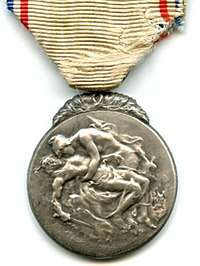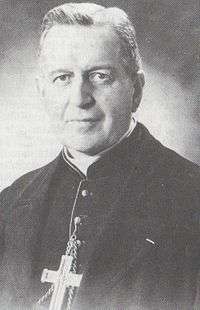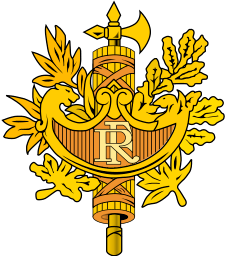Medal of French Gratitude
| Medal of French Gratitude | |
|---|---|
 Bronze level, type 2 (obverse) | |
|
Awarded by | |
| Type | Three grade medal |
| Awarded for | Support to the victims of war |
| Status | No longer awarded |
| Statistics | |
| Established | 13 July 1917 |
| Distinct recipients | ~15,000 |
| Precedence | |
| Next (higher) | Combatant's Cross |
| Next (lower) | Overseas Medal |
|
Bronze | |

.jpg)
.jpg)

The Medal of French Gratitude (French: "Médaille de la Reconnaissance française") was a French honour medal created on 13 July 1917 and solely awarded to civilians.[1] The medal was created to express gratitude by the French government to all those who, without legal or military obligation, had come to the aid of the injured, disabled, refugees, or who had performed an act of exceptional dedication in the presence of the enemy during the First World War. The creation of this distinction was mainly the result of unsuccessful offensives of General Nivelle in 1917 and the serious crisis of confidence in France. The French government thus wanted to thank those who, despite the crisis, were always volunteering. It has three classes: bronze, silver, and gold. Nearly 15,000 people and communities were recipients of this award. The medal is no longer awarded, the last award was on 14 February 1959.[2]
Award statute
The Medal of French Gratitude was awarded following World War I to the following:[1]
- Persons who, in the presence of the enemy, have performed acts of exceptional dedication, the duration of these services having spanned one year (Decree of December 2, 1917)
- Deserving communities (whose members were are not allowed to wear the ribbon or individual medal by decree of December 2, 1917);
- Citizens of Alsace and Lorraine who were deported, exiled or imprisoned, before 1 August 1914, by German authorities because of their attachment to France and those in the departments occupied themselves, for their courageous stand while exposed to reprisals (Decree of 1 April 1922);
- Prisoners of war, civilian prisoners, hostages and deportees because of exceptional acts courage and dedication for the allied cause. The inhabitants of occupied areas or Alsace and Lorraine who helped these people (decrees of 29 November 1926 and December 8, 1928).
Award description
The first model was a 30 mm in diameter circular bronze, silver or gilded medal depending on the level of the award, the design was by engraver Jules Desbois. The obverse bore charity personified by France supporting a wounded soldier. On the reverse at centre, the relief circular inscription "RECONNAISSANCE FRANCAISE" along the circumference with at centre and a palm leaf on the right.
The second model is a 32 mm in diameter circular bronze, silver or gilded medal depending on the level of the award, the design was by engraver Maurice Delannoy. The obverse bears a woman wearing a Phrygian cap representing France offering a palm. On the reverse, the relief inscription RECONNAISSANCE FRANCAISE around a wreath of roses surrounding an escutcheon bearing the initials "RF".
The medal hung from a 37 mm wide white silk moiré ribbon with tricolour 2 mm wide edge stripes of blue, white and red, the blue being outermost.
Notable recipients (partial list)
French citizens
- Writer Camille Marbo
- General Marie-Pierre Kœnig
- Politician Raoul Bleuse
- Lawyer Pierre Kédinger
- Politician Charles Ehrmann
- Resistance fighter Albert Kohan
- Herminie de La Brousse de Verteillac, Princesse of Léon
- Doctor Léandre Dupré
- Resistance fighter Charles Fenain
- Marquise Corisande de Gramont
- Doctor Alfred Cerné
- Father Émile Blanchet
Foreign nationals
- Lucile Atcherson Curtis, diplomat

- Barbara Borsinger, nurse

- Prince Boun Oum

- Alan Burns, 4th Baron Inverclyde

- Marquesa del Ter

- Louis Dewis, activist on behalf of Belgians during World War I and noted landscape artist
.svg.png)
- Marie Galway

- Ethel Gray, nurse

- Lotta Hitschmanova

- Aline Rhonie Hofheimer, pilot

- Helen Kirkpatrick, war correspondent

- Anna Elizabeth Klumpke, artist

- Louise Mountbatten

- Norman Holmes Pearson

- Vere Ponsonby, 9th Earl of Bessborough

- Hunter Scarlett

- Belle Skinner, philanthropist

- Leonie Richarde

Communities Decorated
The Medal of French Gratitude was awarded to six French and eight foreign cities.[1]
French cities
Foreign cities
- Schaffhausen (1919), Basel, Geneva and Lausanne (1921), Montreux (1953).

- Mons (1920).
.svg.png)
- Luxembourg (1921).

- Narvik (1954).

See also
External links
- Chancellery and museum of the Legion of Honour (in French)
- Entente combattants (in French)
French medals by order of precedence==References==
- 1 2 3 Champenois, Marc (January 2004). "Médaille de la Reconnaissance française". France Phaleristique (in French). Archived from the original on 2010-08-15. Retrieved 2010-12-06.
- ↑ "Décorations". Comité d'Entente d'Associations de Combattants de l' Hérault (in French). 2005. Archived from the original on 2011-07-10. Retrieved 2010-12-06.
